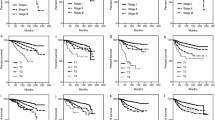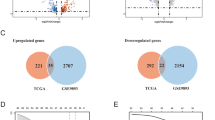Abstract
Histological sections of the primary tumour and of homolateral axillary lymph nodes from 500 women with operable invasive breast cancer have been examined. The tumours have been graded and the degree of round cell infiltration assessed. These features, together with clinical palpability and pathological involvement of axillary nodes, have been related to survival.
It was found that prognosis was worse in patients with a high grade tumour and in those with histological evidence of axillary node spread. Round cell infiltration of the primary tumour did not confer improved survival.
The clinical state of the axillary nodes was associated with prognosis in so far that palpable nodes were twice as commonly the seat of metastatic spread as were impalpable nodes.
This is a preview of subscription content, access via your institution
Access options
Subscribe to this journal
Receive 24 print issues and online access
$259.00 per year
only $10.79 per issue
Buy this article
- Purchase on Springer Link
- Instant access to full article PDF
Prices may be subject to local taxes which are calculated during checkout
Similar content being viewed by others
Rights and permissions
About this article
Cite this article
Champion, H., Wallace, I. & Prescott, R. Histology in Breast Cancer Prognosis. Br J Cancer 26, 129–138 (1972). https://doi.org/10.1038/bjc.1972.19
Issue Date:
DOI: https://doi.org/10.1038/bjc.1972.19
This article is cited by
-
The Immunology of Breast Cancer
Clinical Immunotherapeutics (1995)
-
The possible role of stromal cell stimulation in worsening the prognosis of a subset of patients with breast cancer
Clinical & Experimental Metastasis (1993)
-
The Nottingham prognostic index in primary breast cancer
Breast Cancer Research and Treatment (1992)
-
Influence of diet on breast cancer size and morphology in rats treated with DMBA
Archives of Gynecology and Obstetrics (1991)
-
Study of the relationship between immunohistologically demonstrated lymphocytes infiltrating human breast carcinomas and patients' survival
Journal of Cancer Research and Clinical Oncology (1991)



